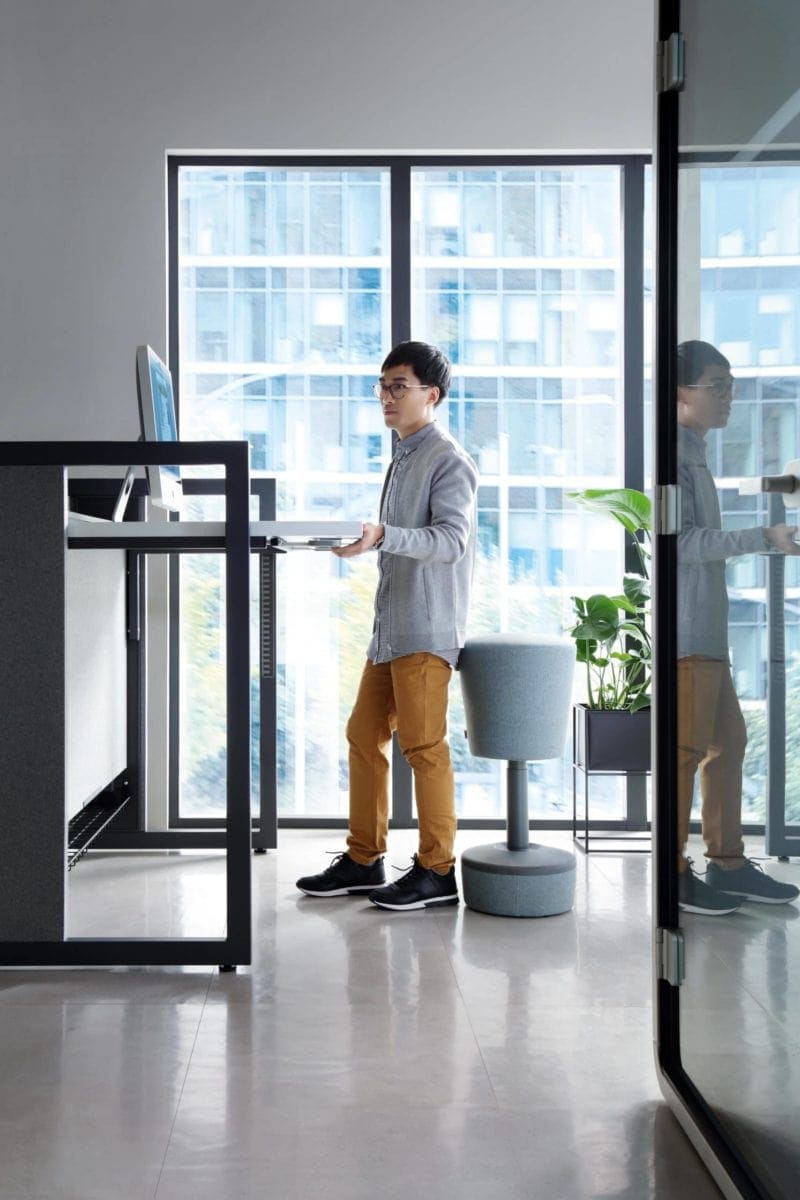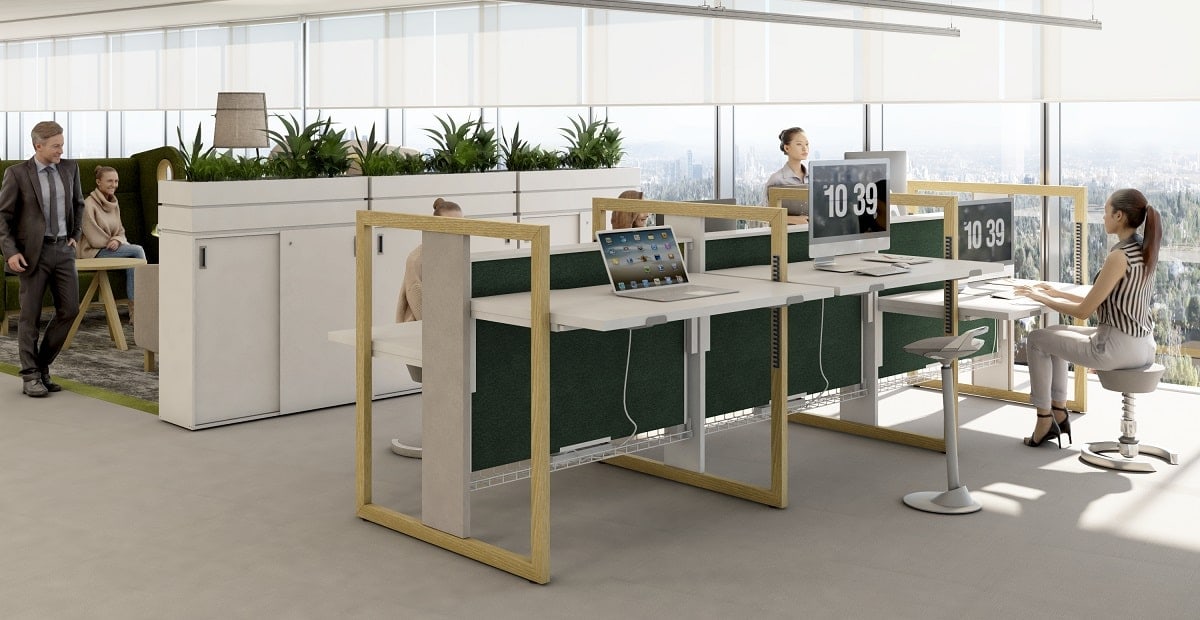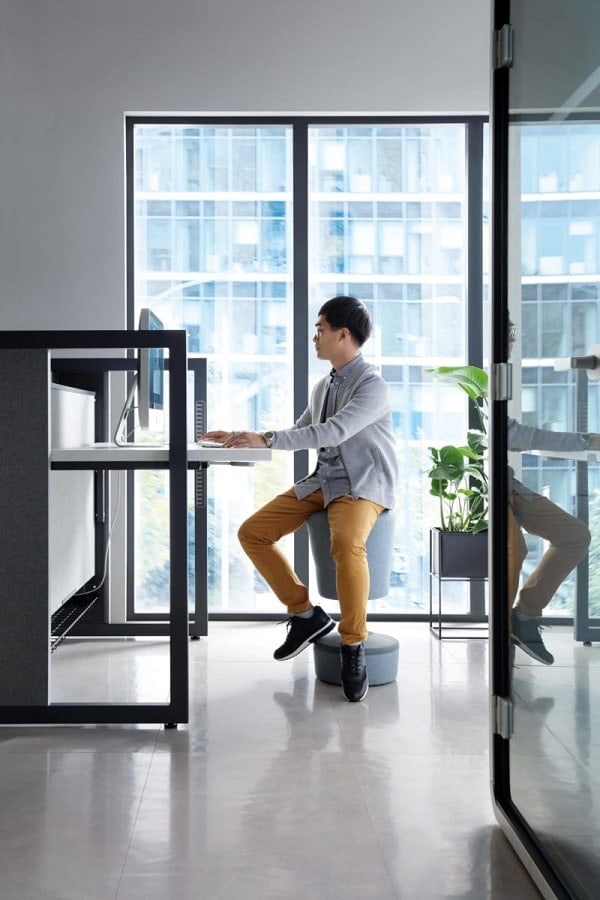3 ergonomics essentials for the office

More than half of the workforce now expects support for their health and well-being. It’s ranked second in priority — more important than salary. In fact, 82% say their employer must see them as whole people, not just workers.
It’s clear that, increasingly, wellness is where it’s at.
Office ergonimics – tl;dr
- The three ergonomics essentials: tweak each employee’s desk to facilitate a healthy typing posture, invest in sit-to-stand desks, and take frequent breaks
- In a healthy typing posture, your feet are flat on the floor, your upper body is balanced atop your hips, your shoulders are relaxed, your elbows form a 90° angle when typing as are your hands in line with your forearms, and your eyes view the screen with ease
- For optimal ergonomics — i.e., comfort and health — place your screen an arm’s length away and directly in front of you, tilt it to reduce glare, and adjust its height, so its top line is at or slightly below eye level
- Encourage anyone with pain or strain in their mousing hand to switch hands periodically
- Teammates with discomfort in the fingers specifically may benefit from typing softer, as “hard” typing can cause musculoskeletal problems, too
- A fluidly height adjustable benching desk like STAND UP R makes sound ergonomic sense because it allows the user to move through postures — without inhibition or interruption — while they work, preventing static load (which leads to fatigue and, in some cases, injury)
One of the most practical ways to support employee wellness is through ergonomics.
Give each of your team members an ergonomic desk setup. Make it height adjustable for maximum mobility. And help them catalyze healthy work patterns by encouraging breaks. These three essentials make for a rock-solid foundation.
Ergonomics is a beautiful focus because it’s all about the employee. Fine-tuning their desk for the most comfortable workflow. Providing for sit-stand freedom. Redefining your organization’s culture to give proper priority to rest, thus spurring each teammate to break throughout the day. When we focus on ergonomics, we’re really focusing on the individual employee, which is only apt
– says Eliza Donek, Product Manager, Mikomax.
Ergonomics essential #1. Tweak each employee’s desk to facilitate a healthy typing posture.
Good desk posture is a telltale indicator that proper ergonomics are in place. And being that sitting in an awkward posture increases the likelihood of low back pain and sciatica, it’s crucial that we put the proper ergonomics into place that allow us to sit “right.”

What is a healthy typing posture (in a sitting position)?
Your feet are flat on the floor. Your torso, neck, and head are balanced atop your hips. Your shoulders are relaxed. When typing, your elbows are at a 90° angle, your hands are in line with your forearms, and your eyes see the screen with ease.
Posture is integral. It can keep everything from back pain to headaches at bay. It boosts your lung capacity, improving your breathing for innumerable benefits. It boosts your confidence, too. It’s not just how you feel, but how you think; we process differently when our body is aligned and upright
– offers Eliza Donek, Product Manager, Mikomax.
Why does typing posture matter?
Most people spend 70% of their workday typing. So good typing posture is just good sense. It protects you from pains, strains, and discomfort through the back and upper body by keeping you well stacked — when you’re well stacked, no muscle compensates unhealthily for another’s unnatural slackness.
Prevent Repetitive Stress Injuries (RSIs) and Cumulative Trauma Disorders (CTDs).
When your posture is on point, you’re working in a neutral position. One that causes no undue stress on the body and is, in a word, comfortable. On the other hand, poor posture increases your chance of developing carpal tunnel syndrome, arthritis, tendonitis, tech neck, and other RSIs and CTDs.
It’s all about how your desk is set up.
Set up right, you’re never lurching forward, nor are your eyes ever squinting to view your screen. Your body feels grounded yet poised. You have no symptoms of Computer Vision Syndrome (which affects 70% of adults) because your eyes can easily scan and read the monitor.

4 steps: setting up the desk for a healthy typing posture
- Adjust your chair height so your feet are flat on the floor, not dangling, cutting off blood flow. Use a footrest if needed. Fix your keyboard height so your elbows make a 90° angle when you’re typing and your shoulders are relaxed. An adjustable keyboard tray may help you achieve this. If your chair has arms, make sure they aren’t obstructing movement as you type.
- Place your monitor/screen about an arm’s length away, centered in front of you. Tilt it to eliminate any glare. Adjust its height, so the top line of the screen is at or slightly below eye level. Fix its light setting to a pleasant amount, reducing blue lights if possible. You should be able to clearly read the screen without lurching forward or backward (or straining your eyes). An external monitor, a laptop or monitor riser/stand, or a monitor arm may be needed to achieve this.
- Center the keyboard so the spacebar is lined up with your sternum and your thumbs fall on its center when typing. Ensure it lies flat or is sloped downward away from you, not angled upward, as an upward angle will create wrist extension, greatly reducing circulation through your wrists (potentially causing pain, fatigue, and numbness).
- Place your mouse on the same level as your keyboard, relatively close to it. Your arm should be in an enjoyable position when mousing. Make sure your mouse fits your hand, allowing for a comfortable hold as well. If you pinch your fingers when mousing, your mouse may be too small. If you spread your fingers apart widely, your mouse may be too big. Both can lead to fatigue and discomfort in the fingers, wrist, and elbow.
For more detailed guidance, check out OSHA’s Ergonomics Evaluation Checklist.
Do you have employees with wrist/hand problems?
Encourage anyone with pain or strain in their mousing hand to switch hands every so often. And advise teammates with discomfort in the fingers specifically to practice typing softer. “Hard” typing can lead to musculoskeletal symptoms, too.
Ergonomics essential #2. Invest in height-adjustable workstations.
Sitting or working in the same position for hours — or doing the same minor movements like clicking or scrolling for hours — builds up static load. Static load fatigues and wears out the body, increasing its risk for RSIs and CTDs like lumbar back pain and epicondylitis (computer/mouse elbow).

Our musculoskeletal system is a movement system. It’s built for motion.
Ergonomists put it well: the next position is the best position. So a height adjustable workstation like STAND UP R makes sound ergonomic sense; it allows the user to fluidly move through postures while they work.
Ergonomics essential #3. Make taking breaks a thing.
When it comes to work and life, stress is not the enemy. Poor recovery from stress is. Really, recovery must be purposefully built into our lives — scheduled in and made a non-negotiable part of each day. At work, this means taking basic breaks, whether to shake out your legs, let your wrists rest, or simply just stare off into space
– lends Eliza Donek, Product Manager, Mikomax.
Ergonomics is all about calibrating our work environments and patterns for health. Its aim is harmony. Well-being. Higher quality output. Breaks are a critical piece of its puzzle. While cognitive breaks allow your brain to rest, physical breaks allow your body to reset. Both matter.
1. Step away… from the desk
And move. Walk and talk with a friend for five. Stretch your hip flexors in the lounge. Do a set of jumping jacks on the patio. A sun salutation. A series of slow squats or lunges. Triceps dips using the arms of a stable chair. Calf raises. Movement is movement.

1. Keep your eyes in mind
Try the 20-20-20 rule. Look at an object at least 20 feet away for 20 seconds every 20 minutes. The habit will reduce eye strain. And be sure to blink as you work. People blink up to 5X less frequently while computing, which can lead to red, dry eyes and even blurred vision.
2. Give your wrists (and hands) a rest
For knowledge workers, hands and wrists are tools. Just like all the other parts of the body, they need recovery breaks after extended periods of use. Otherwise, their tendons and muscles are kept tense for too long and are subject to injuries.
3. Relax
Much pain and strain are caused by the habitual holding of tension. And many of us are unaware of the tension we even hold. So try spending a minute deliberately slackening your muscles after every break before you get back to work.
4. Desk-ercise
Take a minute to reset one part of your body. No need to leave your desk or even stand up; all movement is beneficial. A mere neck rotation or chin tuck can be the sweetest reset. For ideas, check out the University of Michigan’s list of desk exercises (beneath “Exercise at Your Computer”).
Lead by example. Take breaks (to make taking breaks a thing).
Hustle culture is burning out. Taking its place is a culture that prioritizes rest. Your power lies in modeling a healthy work-rest cycle by taking breaks. You’ll give your employees the gift of permission to take breaks themselves and ultimately realize happier, more effective working.
How does that sound to you?
Office ergonomics – tl;dr
- The three ergonomics essentials: tweak each employee’s desk to facilitate a healthy typing posture, invest in sit-to-stand desks, and take frequent breaks
- In a healthy typing posture, your feet are flat on the floor, your upper body is balanced atop your hips, your shoulders are relaxed, your elbows form a 90° angle when typing as are your hands in line with your forearms, and your eyes view the screen with ease
- For optimal ergonomics — i.e., comfort and health — place your screen an arm’s length away and directly in front of you, tilt it to reduce glare, and adjust its height, so its top line is at or slightly below eye level
- Encourage anyone with pain or strain in their mousing hand to switch hands periodically
- Teammates with discomfort in the fingers specifically may benefit from typing softer, as “hard” typing can cause musculoskeletal problems, too
- A fluidly height adjustable benching desk like STAND UP R makes sound ergonomic sense because it allows the user to move through postures — without inhibition or interruption — while they work, preventing static load (which leads to fatigue and, in some cases, injury)
Office ergonomics – frequently asked questions
What is an RSI?
A repetitive strain or repetitive stress injury is an injury caused by repeated, dysfunctional use of the body. Common RSIs at the desk include carpal tunnel syndrome, computer/mouse elbow, and arthritis.
How do I know if an employee’s desk setup is ergonomic?
Are their feet flat on the floor? Are their torso, neck, and head balanced atop their hips? Are their shoulders relaxed? When typing, are their elbows at a 90° angle and their hands in line with their forearms? Can they view their monitor screen with ease (without lurching forward or squinting their eyes)?
What is the most ergonomic adjustable height desk?
Consider a desk like STAND UP R, that switches from sit to stand smoothly in seconds, allowing employees to change postures at whim without interrupting their work. STAND UP R also has a wide desktop, offering plenty of space for a dual or triple monitor setup.
